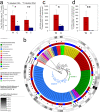Winter warming in Alaska accelerates lignin decomposition contributed by Proteobacteria
- PMID: 32503635
- PMCID: PMC7275452
- DOI: 10.1186/s40168-020-00838-5
Winter warming in Alaska accelerates lignin decomposition contributed by Proteobacteria
Abstract
Background: In a warmer world, microbial decomposition of previously frozen organic carbon (C) is one of the most likely positive climate feedbacks of permafrost regions to the atmosphere. However, mechanistic understanding of microbial mediation on chemically recalcitrant C instability is limited; thus, it is crucial to identify and evaluate active decomposers of chemically recalcitrant C, which is essential for predicting C-cycle feedbacks and their relative strength of influence on climate change. Using stable isotope probing of the active layer of Arctic tundra soils after depleting soil labile C through a 975-day laboratory incubation, the identity of microbial decomposers of lignin and, their responses to warming were revealed.
Results: The β-Proteobacteria genus Burkholderia accounted for 95.1% of total abundance of potential lignin decomposers. Consistently, Burkholderia isolated from our tundra soils could grow with lignin as the sole C source. A 2.2 °C increase of warming considerably increased total abundance and functional capacities of all potential lignin decomposers. In addition to Burkholderia, α-Proteobacteria capable of lignin decomposition (e.g. Bradyrhizobium and Methylobacterium genera) were stimulated by warming by 82-fold. Those community changes collectively doubled the priming effect, i.e., decomposition of existing C after fresh C input to soil. Consequently, warming aggravates soil C instability, as verified by microbially enabled climate-C modeling.
Conclusions: Our findings are alarming, which demonstrate that accelerated C decomposition under warming conditions will make tundra soils a larger biospheric C source than anticipated. Video Abstract.
Conflict of interest statement
The authors declare no conflicts of interest.
Figures




References
-
- Xue K, Yuan MM, Shi ZJ, Qin Y, Deng Y, Cheng L, et al. Tundra soil carbon is vulnerable to rapid microbial decomposition under climate warming. Nat Clim Chang. 2016;6(6):595–600.
-
- Vonk JE, Sánchez-García L, Van Dongen B, Alling V, Kosmach D, Charkin A, et al. Activation of old carbon by erosion of coastal and subsea permafrost in Arctic Siberia. Nature. 2012;489(7414):137. - PubMed
-
- Natali SM, Schuur EA, Trucco C, Hicks Pries CE, Crummer KG, Baron Lopez AF. Effects of experimental warming of air, soil and permafrost on carbon balance in Alaskan tundra. Glob Chang Biol. 2011;17(3):1394–1407.
-
- Davidson EA, Janssens IA. Temperature sensitivity of soil carbon decomposition and feedbacks to climate change. Nature. 2006;440(7081):165–173. - PubMed
-
- Schuur EA, Vogel JG, Crummer KG, Lee H, Sickman JO, Osterkamp T. The effect of permafrost thaw on old carbon release and net carbon exchange from tundra. Nature. 2009;459(7246):556–559. - PubMed
Publication types
MeSH terms
Substances
Grants and funding
- DE-SC0004601/U.S. Department of Energy/International
- DE-SC0010715/U.S. Department of Energy/International
- 41430856/National Natural Science Foundation of China/International
- 41877048/National Natural Science Foundation of China/International
- 41825016/National Natural Science Foundation of China/International

